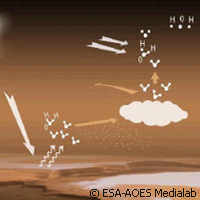Martian atmosphere holds supersaturated water vapour
European space scientists led by the Laboratoire Atmosphères, Milieux, Observations Spatiales (LATMOS) in France have discovered that the Martian atmosphere contains water vapour in a supersaturated state. Presented in the journal Science, the result will help boost researchers' knowledge about the water cycle on the Red Planet and the changes in its atmosphere. Our planet's water vapour tends to condense, especially when the temperature drops below the dew point. Astronomers say a saturated atmosphere is triggered by failure of the atmosphere to hold moisture at that temperature and pressure. The excess water vapour then condenses around suspended particles and dust, and in turn creates precipitation. But condensation is not always a quick process; a lack of particles and dust could slow it down. When condensation does not happen at all, the excess water vapour remains in the gaseous state, what experts call 'supersaturation'. Researchers have long postulated that this phenomenon could not occur in the Martian atmosphere ... until now. Over the last 40 years, expeditions to Mars have focused on collecting surface data; this restricted researchers' observations to the horizontal component of the Martian atmosphere. There was scant information on how water content on Mars varies with height. But this latest study, carried out by the Spectroscopy for Investigation of Characteristics of the Atmosphere of Mars (SPICAM) spectrometer on board the Mars Express spacecraft, has changed this. According to the team's French and Russian astronomers, SPICAM can create vertical profiles of the atmosphere using solar occultation, i.e. by observing light from the Sun as it travels through the Martian atmosphere at sunrise and sunset. Their data effectively substantiate that water vapour supersaturation is a common occurrence on Mars. Significantly high levels of supersaturation - up to 10 times greater than those found on Earth - were also observed in the Martian atmosphere. 'This ability of water vapour to exist in a highly supersaturated state would, for example, allow to supply the southern hemisphere of Mars with water, far more efficiently than models currently predict,' says Franck Montmessin, SPICAM project leader and Centre National de la Recherche Scientifique (CNRS) researcher at LATMOS. The CNRS is one of the supervisory authorities for LATMOS, as are the University of Versailles Saint Quentin (UVSQ) and the University of Pierre et Marie Curie (UPMC). It should be noted that a larger quantity of water vapour could be transported high enough in the atmosphere only to be damaged by photodissociation. If this happens to be the case, the phenomenon would have consequences for the entire issue of Martian water as discussed by the scientific community. Because a good portion of water vapour has continually escaped into space for billions of years, experts believe it provides insight into today's low abundance of water on the planet. According to the scientists, the vertical distribution of water vapour is a key factor that should be taken into account when studying the hydrological cycle on Mars. Researchers will have to reconsider the issue of how the amount of water in the Martian atmosphere is restricted by the saturation process.For more information, please visit: CNRS:http://www.cnrs.fr/Science:http://www.sciencemag.org/
Countries
France, Russia



